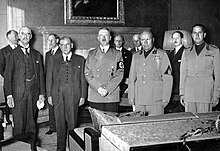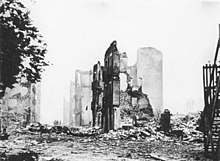Invasion of Ethiopia
The Second Italo–Abyssinian War was a brief colonial war that began in October 1935 and ended in May 1936. The war was fought between the armed forces of the Kingdom of Italy (Regno d'Italia) and the armed forces of the Ethiopian Empire (also known as Abyssinia). The war resulted in the military occupation of Ethiopia and its annexation into the newly created colony of Italian East Africa (Africa Orientale Italiana, or AOI); in addition, it exposed the weakness of the League of Nations as a force to preserve peace. Both Italy and Ethiopia were member nations, but the League did nothing when the former clearly violated the League's own Article X.Spanish Civil War
Germany and Italy lent support to the Nationalist insurrection led by general Francisco Franco in Spain. The Soviet Union supported the existing government, the Spanish Republic which showed leftist tendencies. Both sides used this war as an opportunity to test improved weapons and tactics. The Bombing of Guernica, a city of 5000 - 7000 inhabitants, was considered a horrifying attack at the time, with a propaganda figure of 1,654 people killed widely circulated in the west, leading to charges of "terror bombing". In reality the attack was tactical operation against a city with militarily important communications close to the front-line, and modern estimates yield no more than 300 - 400 dead at the high-end.Japanese invasion of China

A Chinese machine gun nest in the Battle of Shanghai, 1937.
In June 1938, Chinese forces stalled the Japanese advance by flooding the Yellow River; although this manoeuvre bought time for the Chinese to prepare their defences at Wuhan, the city was taken by October. Japanese military victories, however, did not bring about the collapse of Chinese resistance that Japan had hoped to achieve, instead the Chinese government relocated inland to Chongqing to continue their resistance.
Japanese invasion of the Soviet Union and Mongolia

Soviet troops fought the Japanese during the Battle of Khalkin Gol in Mongolia, 1939.
These clashes convinced the Japanese government that they should focus on conciliating the Soviet government to avoid interference in the war against China and instead turn their military attention southward, towards the US and European holdings in the Pacific. They also prevented the sacking of experienced Soviet military leaders such as Zhukov, who would later play a vital role in the defence of Moscow.
European occupations and agreements
Further information: Anschluss, Appeasement, Munich Agreement, German occupation of Czechoslovakia, and Molotov-Ribbentrop Pact

From left to right (front): Chamberlain, Daladier, Hitler, Mussolini, and Ciano pictured before signing the Munich Agreement.
Alarmed, and with Hitler making further demands on Danzig, France and Britain guaranteed their support for Polish independence; when Italy conquered Albania in April 1939, the same guarantee was extended to Romania and Greece. Shortly after the Franco-British pledge to Poland, Germany and Italy formalised their own alliance with the Pact of Steel.
In August 1939, Germany and the Soviet Union signed the Molotov–Ribbentrop Pact, a non-aggression treaty with a secret protocol. The parties gave each other rights, “in the event of a territorial and political rearrangement,” to “spheres of influence” (western Poland and Lithuania for Germany, and eastern Poland, Finland, Estonia, Latvia and Bessarabia for the USSR). It also raised the question of continuing Polish independence.

0 comments:
Post a Comment